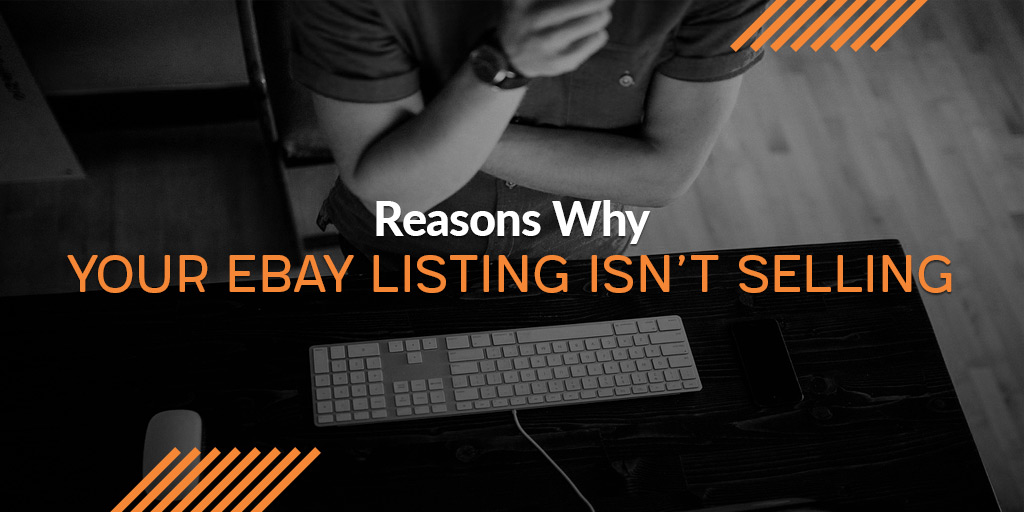
Opening a shop is easy, but selling is much harder.
It’s true whether you’re selling on eBay or a brick-and-mortar store.
The good news is that you can learn to become a more successful eBay seller. With the right strategy in place, you can increase your sales, develop customer loyalty, and win at life. Let’s talk about what you may be doing wrong (no judgment) and how to fix it.
1. You Don’t Have Any Feedback
When given the choice between a seller with a proven track record and a seller who just opened shop and doesn’t have any feedback at all, who would you go with? Probably the seller who others can vouch for. It harkens back to that wisdom that says “there’s safety in numbers”. If a seller generates enough positive reviews, it adds an extra level of trust in the eyes of the buyer.
Unfair but true.
That’s why you need to ask for feedback.
The secret to establishing your seller rating is to start off selling inexpensive items that people won’t mind taking a chance on. This way you can begin accruing feedback from small sales, which will help you make bigger sales in the future.
2. You’re Not Optimizing Your Listing Title
You need to stuff as many relevant keywords as possible into the title of your listing. Otherwise, you may miss potential buyers.
Start with the basic keywords that describe your item. How would the average person search for your listing? What words would they use in the search box?
Those are the precise words you should use in your listing title.
In some cases, the brand name can also be an essential part of the listing title. Some eBay users are exclusively looking for Nike, Coach, Prada, Ralph Lauren, Samsung, Dell, etc. If you think adding the brand name to your title will improve its exposure, include it. If not, definitely include it in the detailed description you’ll write (more on that next).
3. You’re Not Optimizing Your Listing Description
You knew this was coming. You need a detailed description of your product. That’s in addition to a thoughtful title and a gaggle of images. Buyers should come away from your listing feeling completely informed.
Why is this important? An informed buyer is an empowered one. He or she will be more willing to trust you because you’ve taken the time to describe exactly what you’re explaining. It builds trust and credibility, which will increase your chance of closing the sell.

4. You’re Charging the Wrong Price
If you’re making this error, you’re not alone. A lot of eBay sellers inflate the price of a listing– and it’s not out of greedy intent. A lot of sellers honestly don’t know what the item should sell for.
This is especially true with gently used items. What the market will pay for a used, opened item is definitely lower than for new, unopened items, by at least 10%, and sometimes way more, depending on the item.
But should you just take a guess and cross your fingers that someone will be willing to pay for it?
Fortunately, you don’t have to do that at all. You can actually use eBay to find out what similar items have sold for.
To do this, perform an advanced search for your item, being sure to select the “sold listings” search parameter.
By doing this, you have an opportunity to gauge the current market and settle on a price that’s competitive with the rest of the market. You don’t want to undersell and you definitely don’t want to oversell if it means that buyers won’t even consider your listing.
5. You’re Starting Your Auction Too High
Interested in auction listings?
Auctions have a lot of benefits. Here are three:
Auctions are almost guaranteed sells. Unless you start with an impossibly high bid or you place a minimum reserve price (which is often a smart idea), you’ll likely make a sell.
Auctions help determine pricing. If you have no idea what your item should sell for because it’s unlike any other item sold on eBay, you can use an auction to determine the price that the market is willing to pay.
Auctions often drive up the sell beyond what you were expecting to make. Sure, it’s a gamble, but often, you’ll end up with a higher payout because many eBay users are competitive, and like to bid until the very last moment.
To derive the biggest benefit from your auction listings, it’s a good idea to start low. Low prices create bidder frenzy. They’ll attract the attention of more buyers, and quickly raise the price.
You’ll also want to list for longer periods of time (up to 30 days) to increase the item’s exposure to potential bidders. A lot of bidders watch items and circle back towards the end of the auction to make their bid.
6. You Didn’t Include Photos
Photos will make or break the deal. Most eBay users are extremely discerning. They won’t just “take your word on it”. They need to see the visual evidence in order to buy your product.
In fact, some buyers won’t even click on your item if you don’t have a photo.
Photos are an essential part of your marketing. It’s how you’ll stop a buyer from scrolling past your item. Sure, your item description does help, but most people are visual and are compelled by an image that matches what they’re looking for.
Plus, you don’t have much of an excuse not to snap a decent, high-resolution photo of your item these days. If you own a smartphone, you have all the equipment you need.
Consider taking multiple photos from different angles. If you don’t have access to fancy camera lights, simply position the item near a window that gets plenty of afternoon sun and snap away.
Don’t use standard stock images. It gives off the impression that you’re trying to hide something from your buyer.
7. You’re Not Using a Template
One of the most important elements of your eBay listing is presentation. How you present your listing matters to buyers.
It’s not enough to have photos of the product or even a detailed description. Both are important, but are parts of a whole.
The whole is your cohesive design that allows you to highlight your product, cross promote complementary products, explain your store policies (shipping, returns, refunds, etc), and answer frequently asked questions.
You can do all of that (and more) from your listing page with the right eBay listing template. Implementing a template will immediately elevate your listing. You can inform and delight prospective buyers with an optimized and professional looking listing.
Click here to learn more about how we custom design eBay listings for our clients.
Final Thoughts
The good news is that the success of your eBay shop is easy to realize if you follow the above tips and strategies.









Be the first to leave a comment. Don’t be shy.